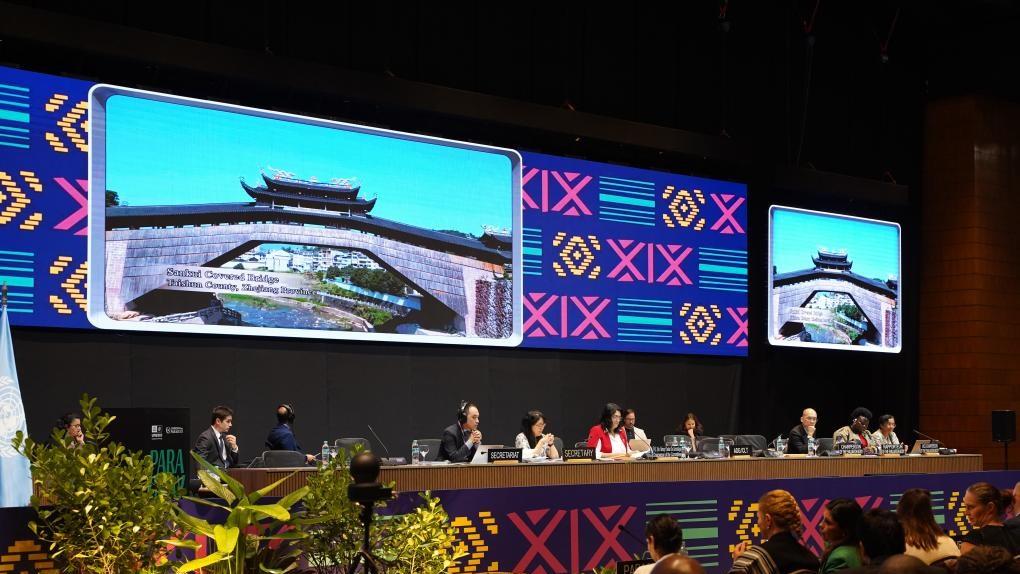Unraveling the charm of traditional Li textile techniques
HAIKOU, Dec. 6 (Xinhua) -- As a child, Liu Xianglan was captivated by the vibrant colors and intricate patterns of Li brocade. In her adulthood, this craft became her life's work.
So she was ecstatic when she heard that the United Nations Educational, Scientific and Cultural Organization (UNESCO) had added traditional Li textile techniques to its Representative List of the Intangible Cultural Heritage of Humanity.
"The government attaches great importance to the protection and inheritance of traditional Li textile techniques, and the efforts have only increased in recent years," said the 55-year-old national-level inheritor of traditional Li textile techniques, who hails from the city of Wuzhishan in south China's Hainan Province.
Often referred to as a "living fossil" of the textile industry, Li textile techniques have been practiced for more than 3,000 years by people of Hainan's Li ethnic group, ranking among the oldest cotton spinning methods in the world.
This intricate art form combines ancient practices of spinning, dyeing, weaving and embroidery to produce vibrant fabrics embellished with exquisite patterns and unique textures. Recognized as a world-class intangible cultural heritage, Li brocade stands as a testament to a rich and enduring cultural legacy.
On Thursday, UNESCO inscribed traditional Li textile techniques of spinning, dyeing, weaving and embroidering to its Representative List of the Intangible Cultural Heritage of Humanity. The techniques were already included in the List of Intangible Cultural Heritage in Need of Urgent Safeguarding in 2009.
"This is the best thing," said Liu. "I am so happy!"
Liu began learning the Li textile techniques from her mother when she was 13.
"I always dreamed that I could make the beautiful Li brocade items that my mother created," she said.
Passing on the craft has always been Liu's biggest wish.
In 2013, Liu established a studio in her village in Wuzhishan City. She invited local women to join her in weaving Li brocade, encouraging them to help preserve and pass down the ancient textile techniques.
A year later, Liu set up her own company, which not only sells traditional Li brocade clothing, but also takes orders for other cultural and creative products such as tapestries and bed runners. The company thrived, and annual turnover stood between 800,000 yuan (110,167 U.S. dollars) to 1 million yuan.
"Our company employees used to be farmers," Liu said. "But through learning the Li textile techniques, they not only helped inherit the culture and craft of our ancestors, but also increased income and improved their life."
In recent years, Hainan has earmarked significant funds to preserve the ancient craft, including funds to open Li brocade training schools, build training bases and train new practitioners. Since 2012, the art has been introduced as a special course in primary and secondary schools in Hainan. The provincial government has also formulated measures to strengthen the systematic protection, creative transformation and innovative development of Li brocade.
So far, the number of inheritors of this enduring craft has grown from less than 1,000 in 2009 to more than 20,000. More than 100 primary and secondary schools in the province have launched courses on the techniques, and five training studios and 16 "inheritance villages" have been established in six cities and counties across the province, according to the provincial tourism and culture department.
To further promote the development and inheritance of Li brocade skills, Hainan has also encouraged and helped the inheritors to go abroad.
In April 2023, a cultural exchange event in Italy's Milan presented Li brocade clothing to the applause of the viewers there. This May, Li brocade received widespread praise during Hainan's intangible cultural heritage exhibition tour in Malta, Germany and Bulgaria.
Liu has presented Li textile techniques to foreign audiences many times.
"I am very happy to see the exchange and cooperation between Chinese Li brocade culture and world fashion," she said. "I look forward to more opportunities to show the charm of Chinese culture to the world."
Photos
Related Stories
- People visit China Pavilion during COP16 in Riyadh
- Global delegates draw on wisdom of ancient Chinese military masterpiece "The Art of War"
- Three Chinese cultural elements added to intangible cultural heritage list
- More Chinese youth embracing traditional culture: museum curator
- China, Czech Republic strengthen ties through "Study in China" exhibition
Copyright © 2024 People's Daily Online. All Rights Reserved.









